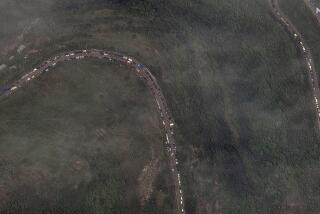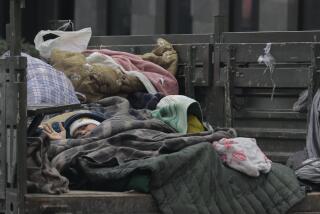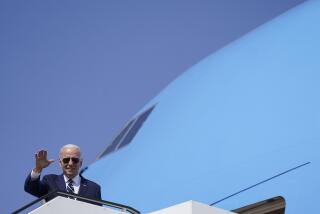Baker’s Central Asia Trip Poses Diplomatic Challenge : Foreign policy: The U.S. wants to gain influence in the region without helping its Communist rulers.
- Share via
WASHINGTON — The Bush Administration is launching a new initiative in Central Asia, one of the last frontiers for U.S. foreign policy and one of the most problematic. Four of the region’s five republics are the last bastions of unrepentant Communist rule in the new Commonwealth of Independent States. They are also the most impoverished and in need of outside help.
The challenge will be to foster and expand Western influence in the predominantly Muslim states without further entrenching undemocratic rule through diplomatic recognition or significant economic aid.
Reflecting the heightened U.S. interest in the region that once constituted almost 20% of the Soviet landmass and population, Secretary of State James A. Baker III will make a special trip this week to hold talks in Uzbekistan, Tajikistan and Turkmenistan.
His only previous visits to Central Asia since the aborted Soviet coup last August were to Kazakhstan, mainly to discuss nuclear weapons, and a day trip to Kyrgyzstan, the region’s only quasi-democracy.
As the revolution in the former Soviet Union has continued to unfold, the import of this remote region’s future path, so far obscured by the political writhings of Goliath Russia and Ukraine, has begun to loom larger. Choices the newly independent states will make in their economies, their governments and their international ties, say U.S. officials and private analysts, could help determine the direction of much of the Asian subcontinent.
“Central Asia is a place where China, Iran, Turkey and, to a lesser extent, Pakistan and Afghanistan are now defining their strategic interests,” said Martha Brill Olcott, a Colgate University specialist on the region.
“So even if we decide it’s not worth our direct intervention, we have to deal with the consequences of other people intervening. . . . What happens in Central Asia will also eventually affect the balance of power in the Persian Gulf, South Asia, the Mideast and, to a lesser degree, China.”
Many U.S. experts expect the border between the Slavic or European republics and Central Asia to eventually become the most important dividing line inside the new Commonwealth, as well as between Europe and Asia.
Behind Baker’s trip, said one senior Administration official, “is a general feeling that the geography and status of Europe and Asia are now in flux, and Central Asia sits on the front line between these two worlds.”
As the new states define their place in the world, the United States hopes to encourage the evolving republics to look toward Europe and the secular Turkish state for guidance and “strategic orientation,” and away from their neighbors to the south, particularly Iran, he said.
Turkey and Iran are now widely considered competing models for the Central Asian nations, which were once united by such legendary figures as Genghis Khan and Tamerlane in a region, known as Turkestan, stretching from Turkey into western China.
Czarist Russia gradually absorbed chunks of Turkestan in the mid-19th Century but still administered it as a single unit with the old name. The current divisions were made after the Russian Revolution when, fearful of a pan-Turkic or pan-Islamic challenge to Soviet communism, Josef Stalin divided the region into the current republics.
Both Russia and the West now fear the revival of the same forces that could, in turn, inflame passions throughout southern Asia and generate hostility to their mutual interests.
Four of the five republics still speak Turkic-based languages and share a common culture. The one exception is Tajikistan, where the language is close to Persian, the Iranian tongue.
Although at least 23 million Russians live in Central Asia, many of whom were forcibly moved by Stalin to “settle” the Soviet south, the indigenous religion is Islam. New Islamic parties, particularly branches of the Islamic Renaissance Party, are growing in each republic, even though they are outlawed in three of the five states.
Since last fall, Turkey and Iran have both launched serious new diplomatic and aid initiatives in Central Asia. In what may be the opening round of a scramble for influence, Pakistan, China, Saudi Arabia and others, such as South Korea, have also stepped up contacts.
The conditions for establishing productive ties are ripe. With one-dimensional economies based on cotton farming, four of the five republics lack the technology to refine their own production or to develop other new industries.
They have other considerable resources they cannot exploit. Uzbekistan, for example, produced 25% of the Soviet Union’s gold, Olcott said. Kyrgyzstan provided uranium for Moscow’s nuclear weapons and reactors. Four of the five have oil and natural gas.
The Central Asian states need markets for their goods and outside aid and investment to become self-sufficient. And they need relief for a population that is soaring in number--40% of families have seven or more children--and subsisting on incomes averaging half that in Russia.
Jolted by the end of Soviet subsidies, food prices are rising rapidly and living standards are plummeting.
“In many places, it’s not just a matter of preventing things like medical services from deteriorating. They didn’t really exist in the first place,” Olcott said. “They’ll have to start virtually from scratch.”
The United States is eager to get international humanitarian aid into the region. But otherwise, its initiative is primarily diplomatic. “Baker wants to get relations established with everybody (in the new Commonwealth) to the extent possible in a reasonable time frame,” said a State Department official. “But we don’t even have the money to open embassies yet.”
Added the senior Administration official: “We’re very embryonic in our thinking and strategizing. Throughout last fall, we dealt mainly with the European side of the Commonwealth. Now, it’s time to begin focusing on Central Asia, which has been neglected.”
Though belated, regional experts say, the American effort must become multifaceted and long-term. The Administration should have an interest in tapping into the republics’ economic opportunities, and “we also have an interest in stability in Central Asia and the regions that adjoin it. . . ,” said Muriel Atkin, a Central Asian specialist at George Washington University. “Instability in Central Asia can have a ripple effect on places that matter deeply to us.”
Of specific concern is the political evolution of the five former Soviet colonies. All the former chiefs of state in Central Asia are or were Communists, and all the parliaments remain heavily dominated by Communists.
Baker’s visit will be to the three states most effectively controlled by old-line Communists, although some parties have changed their names. The Bush Administration would like to encourage openness to the benefits of democratic alternatives and consideration of secular, pro-Western Turkey as a possible model for change.
Turkey already has agreed to provide 1,000 scholarships to students from each of the new nations and promised to help train economists and new Central Asian diplomats. Ankara is helping build telephone systems and constitute new banks to wean Central Asia away from its reliance on Russia. With varying success, Turkish companies are also trying to drum up new trade deals throughout Central Asia.
But there are limitations. Turkey, which is still looking primarily westward rather than eastward, does not have the resources or technology to tap into the oil, gas and mineral reserves in Central Asia, according to U.S. analysts.
Iran, on the other hand, has the technology for petroleum and mineral development and has become very active in Central Asia since last fall. In November, Foreign Minister Ali Akbar Velayati visited the Central Asian capitals and promised major technical support and assistance for infrastructure improvements.
In January, Tehran opened an embassy in Dushanbe, the Tajik capital, and announced that Tashkent, the Uzbek capital, will become the hub of a new Asian service by Iran Air.
Although Central Asians are predominantly Sunni Muslims while the Iranians are Shiites, U.S. officials fear that Iran intends to tap into the Islamic resurgence in Central Asia. American analysts doubt that any of the new states will emulate Iran’s Islamic revolution, but they are concerned about the potential emergence of religious anti-Western governments.
The Islamic revival has already had an impact on Central Asian politics. Uzbek President Islam Karimov and Tajik President Rahkman Nabiyev, both former and prominent members of the Communist Party, “are trying to convert themselves into Islamic figures,” Olcott said.
“Karimov has opened religious education facilities and halalled meat stores (which deal only in meat slaughtered according to Islamic law),” she said. “He has given back religious property” earlier confiscated by the Soviets. “And he now says he is a believer.”
The most immediate danger, U.S. experts say, is that the absence of change in the republics combined with economic deterioration will increase local support for radical movements that could spread instability.
U.S. specialists are split, however, on the best course of new American policy toward Central Asia.
Some suggest that the Administration should withhold significant aid until democratic and economic reforms are instituted. As their situations disintegrate, this side argues, the Central Asians will have no alternative but to introduce change.
Others advocate providing stabilizing aid to buy time to allow less extremist opposition groups to develop. “If the Central Asian economies get worse--and they’re bad now--that could set the stage for (Islamic) extremists,” said Atkin. “So we have an interest in stabilizing the Central Asian economies with the hope that, in time, the political opposition will grow even stronger and, in a healthier environment, eventually take over.”
A New Strategic Focus
The tongue-twisting names of the new Central Asian states all have the same root. ‘Stan’ means ‘land,’ so, for example, Uzbekistan means ‘land of the Uzbeks’ and Kyrgyzstan means ‘land of the Kirghiz.’ But the borders, carved up by Moscow between 1925 and 1936, were often arbitrary and do not correspond to old tribal or clan divisions. The result is an unhomogeneous--and volatile--population mix, with forced Russian emigres from the 1920s and 1930s adding to the ethnic mishmash. (* denotes places Secretary of State Baker is to visit this week.)
* Uzbekistan
Capital: Tashkent, the former administrative capital of all Central Asia. With more than 20 million inhabitants, Uzbekistan is the most populous Central Asian republic. Vibrant nationalist and religious opposition groups are outlawed. Vast cotton farming, aided by intense irrigation and pesticides, has contributed to the draining of the Ural Sea, once the world’s fourth-largest inland sea, and spawned severe health problems. Russians are about 8% of the population. External border with Afghanistan.
* Turkmenistan
Capital: Ashkabad. The Kara-Kum desert accounts for almost 90% of Turkmenistan, which is traditionally the quietest republic. Political opposition is the least active in the region. Noted primarily for its carpets, horses and Karabul sheep, Turkmenistan has also found deposits of oil and sulfur. Russians are about 10%. External border with Iran and Afghanistan.
* Tajikistan
Capital: Dushanbe. Poorest of all the former Soviet republics, most of Tajikistan is mountainous and unarable. Political opposition, from democrats to Islamists, have been legalized since the Moscow coup attempt, although national elections--the fairness of which were challenged by the opposition--brought a hard-line opponent of reform into power. Russians are about 8%. External border with Afghanistan and China.
Kazakhstan
Capital: Alma-Ata. Twice the size of Alaska, Kazakhstan is the largest Central Asian state--and second only to Russia in the new Commonwealth. Some political opposition is nominally allowed, although without access to the media or large public meetings. Rich with oil, gas, coal and other minerals, Kazakhstan also has nuclear weapons. Russians are about 38%, roughly equal to the Kazakhs. External border with China.
Kyrgyzstan
Capital: Bishkek, recently renamed after the fermented mare’s milk that is the national drink. The only quasi-democracy in Central Asia. A major producer of wool and livestock. Russians are about 22%. External border with China.
More to Read
Sign up for Essential California
The most important California stories and recommendations in your inbox every morning.
You may occasionally receive promotional content from the Los Angeles Times.













